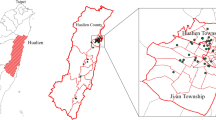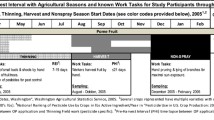Abstract
Two worker-exposure and drift trials were conducted during the aerial application of paraquat to cotton in California, USA. The dermal and respiratory exposure of pilots, flaggers, and a mixer-loader was shown to be low. Dermal exposure ranged from 0.05 (pilot) to 2.39 (flagger) mg/ hr. The dermal exposure of the mixer-loader was similar to that of the pilots. No respirable paraquat was detected in the breathing zone of any worker. The highest total paraquat concentration was 26.3 μg/m3 for a flagger, which is a factor of 19 less than the TLV for total paraquat. The combined dermal and respiratory exposure of this flagger was equivalent to 19.4 mg/8hr working day. Paraquat drift concentrations decreased with increasing distance downwind of the spray application. The highest concentrations of total and respirable paraquat were 16.7 and 0.15 μg/m3 at 50 m from the application site perimeter. The respective concentrations at 1600 m downwind were 0.5 and 0.01 μg/m3. Measurement of the particle size distribution of paraquat drift showed that 0.95 to 1.96% of spray droplets was within the respirable range at all distances downwind. The highest percentage of respirable droplets was equivalent to 1.2 (μg paraquat, which was measured at 400 m downwind. Respirable fractions of 1 and 0.95% were measured at 50 and 100 m downwind, which represented 1.8 μg paraquat. There was no evidence, therefore, of a toxic hazard to pilots, ground crew, and downwind bystanders, as a consequence of the aerial application of paraquat.
Similar content being viewed by others
References
Akesson NB, Yates WE, Cowden RE (1977). Procedures for evaluating the potential losses during and following pesticide application. Paper No 77-1504 presented at the 1977 Winter Meeting of the American Society of Agricultural Engineers, Chicago, Illinois
Andersen 2000 Inc (1976). Operating manual for high volume particle sizing samplers. Andersen 2000 Inc, Atlanta, Georgia
Anonymous (1983). Threshold limit values for chemical sub-stances and physical agents in the workroom environment with intended changes for 1983-4. American Conference of Governmental Industrial Hygienists, Cincinnati, Ohio
Chester G, Woollen BH (1982). Studies of the occupational exposure of Malaysian plantation workers to paraquat. Brit J Ind Med 39:23–33
Documenta Geigy (1972) Scientific Tables. 7th edn. Diem K and Lentner C (ed). Ciba Geigy Limited, Basle, Switzerland
Durham WF, Wolfe HR (1962). Measurement of exposure of workers to pesticides. Bull World Health Org 26:75–91
Fresno County (California) Department of Agriculture (1979). Cotton harvest aid uses. Sacramento, California
Hogarty C (1975). Exposure of spray operators to paraquat. Institute for Industrial Research and Standards, Dublin, Ireland
Jegier Z (1964). Health hazards in insecticide spraying of crops. Arch Environ Health 8:670–674
NIOSH/OSHA (1981). Occupational health guidelines for chemical hazard-paraquat. January. U.S. Department of Health and Human Services, Washington, DC
Orenstein AJ (1960) ed. Recommendations P619. Proc Pneumoconiosis. Conf. Univ of Witwatersrand, Johannesburg, South Africa 1959. J A Churchill, London
Richter ED, Cohen B, Livia M, Schoenberg J, Weisenberg E, Gordon M (1980). Exposure of aerial spray workers to parathion. Isr J Med Sci 16:96–100
Seiber JN, Woodrow JE (1981). Sampling and analysis of air-borne residues of paraquat in treated cotton field environments. Arch Environ Contam Toxicol 10:133–149
Staiff DC, Comer SW, Armstrong JS, Wolfe HR (1975). Exposure to the herbicide paraquat. Bull Environ Contam Toxicol 14:334–340
Swan AAB (1969). Exposure of spray operators to paraquat. Brit J Ind Med 26:322–329
Wojeck GA, Price JF, Nigg HN, Stamper JH (1983). Worker exposure to paraquat and diquat. Arch Environ Contam Toxicol 12:65–70
Wolfe HR, Durham WF, Armstrong JF (1967). Exposure of workers to pesticides. Arch Environ Health 14:622–633
World Health Organization (1982). Field surveys of exposure to pesticides. Standard Protocol, VBC/82.1. Division of Vector Biology and Control, Geneva, Switzerland
Yates WE, Akesson NB, Coutts HH (1966). Evaluation of drift residues from aerial applications. Trans ASAE 9:389–393, 397
Yates WE, Akesson NB, Cowden RE (1974). Criteria for minimizing drift residues on crops downwind from aerial applications. Trans ASAE 17:627–632
Author information
Authors and Affiliations
Rights and permissions
About this article
Cite this article
Chester, G., Ward, R.J. Occupational exposure and drift hazard during aerial application of paraquat to cotton. Arch. Environ. Contam. Toxicol. 13, 551–563 (1984). https://doi.org/10.1007/BF01056333
Received:
Revised:
Issue Date:
DOI: https://doi.org/10.1007/BF01056333




